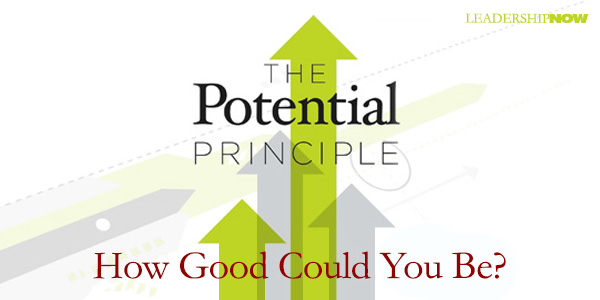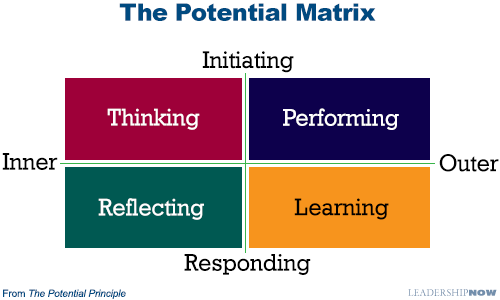
YOU KNOW HOW GOOD you are, but do you know how good you could be?
This is a case where it’s easy to think that good is good enough and get comfortable. Most of us live below our potential. As a result, we miss out on opportunities and therefore live below our true potential and hinder our ability to contribute to others.
The Potential Principle by Mark Sanborn is about how we can become better – even better than our best selves. It’s not about perfect. It’s about better.
So you might ask, “Better at what?” Sanborn presents a program to get you on the road to better. First, you need to figure out just what you want to improve.
What Do You Want to Improve?
Your journey toward better can be organized into four areas: Performing, Learning, Reflecting, and Thinking.
Improvement happens by not only things you initiate like interactive, collaborative activities but also by responding to what you hear, observe, learn as represented by the vertical line. Improvement also takes place in both our inner (things going on inside us) and our outer (things going with others) worlds as represented by the horizontal line. It’s about the inner world of being versus the outer world of performing.

Performing
The top right quadrant is the most familiar to us. “It’s where most of us consciously spend each day doing things: the observable world of initiating, acting, and producing.” It’s what people expect of us when we show up – results. It takes deliberate practice. Performance improvement is not a straight line. There are plateaus. Also, keep in mind the FIT model: Frequency, Intensity, and Technique. How often you practice, the intensity you bring to it and the techniques you use, make all the difference.
Learning
Learning involves the acquisition of new ideas that we put into practice. If we approach life humbly, we will be enriched by what we do not know. Intentional curiosity keeps us growing. “Develop a learning agenda.” Identify what you must or need to learn and then make the time and find the resources to do it.
Reflecting
Reflecting is the inner world of responding. This is an underappreciated value in our instant, tech driven world. It’s about waiting and listening. “Epiphanies—that is, clarity and deeper understanding about yourself and how to improve your life—happen through introspection.” It’s easy to think that we have no time for this and focus on the outer world of doing, but, says Sanborn, “the inner world informs the outer world, and that for the majority of us, going within to understand motivations, hopes fears, and dreams offers some of the greatest leverage to improving every area of our lives.”
Thinking
Think about thinking. “Thinking is about proactively contemplating the world around you. It’s the source of vision, dreams, plans, and strategies. It uses external input and creates connections and directions.” Make the time to think about what you need to learn and unlearn. Focus your thinking and write it down. “Some of the biggest payoffs from thinking will occur when you review notes of previous thinking sessions and add to or modify what you came up with.”
Sanborn explains each of these areas in more detail to help you develop the right mindset. Improvement in these four areas are key to improving consistently.
To be sure, each of us is more comfortable on one or two of these areas. If you are not spending enough time in an area, that will signal an area where you could improve. “Each area complements the others. If you are headed toward better, you’ll want to use each of the four areas identified. Doing so will help you reach your destination sooner and, perhaps more important, enrich the trip.”
Four Tools for Breakthrough Improvement
These four tools will help you “prevent complacency, create improvement, and bust through barriers” on your improvement journey.
- Disrupt Yourself (before someone else does)
“Unwillingness to confront assumptions, challenge your thinking, and try new things is a roadblock to improvement.” It’s proactive rather than reactive. Ask disruptive questions like: “What is the most important lesson I’ve learned this past year? What am I doing out of habit that doesn’t serve me well? - (re)Focus
“Distraction impedes getting better.” - Engage Others
“Self-responsibility is the primary step toward a successful life. But engaging others and building mutually beneficial relationships will leverage everything you do.” Solicit advice, ideas, and counsel. - Expand Your Capacity
There’s room for more. Time x Effort = Capacity. “What one or two skills, if fully developed and consistently deployed, would make the biggest difference in your personal and professional improvement?”
The ideas you will find in The Potential Principle are not all new, but they are organized in such a way as to make them actionable. Sanborn has done a great job of laying the foundation and providing a blueprint for continuous improvement. All you need to do now is to put it into practice.
|
-(Credit: LeadershipNow)




0 Comments
COMMENT
------------------
We love to hear from you, make use of the comment field after every post and drop your comments. Also tick the box in the comments area to get notified via your email for the replies on your comments. Thanks
DISCLAIMER:
*Comments on this Web are NOT posted by Tundegold.
*Readers are SOLELY responsible for the comments they post.
*Also, where necessary, all posts are duly referenced.Thank you.
COPYRIGHT WARNING!
We work really hard and put a lot of effort and resources into our content, providing our readers with plagiarism-free articles, original and high-quality texts.
Contents on this website may not be copied, republished, reproduced, redistributed either in whole or in part without due permission or acknowledgement. Proper acknowledgement include, but not limited to (a) Proper referencing in the case of usage in research, magazine, brochure, or academic purposes, (b)"FAIR USE" in the case of re-publication on online media.
About possible consequences you can read here:What are the consequences of copyright infringement?
Tundegold is a property of Grandunicorn Limited and we have all legal actions at our disposal to take within and outside the internet in effort to protect our intellectual properties. All contents are protected by the Digital Millennium Copyright Act 1996 (DMCA).